The 1940s

With the aim of promoting patriotic education, in the spring of 1946, the board of directors established the new Heung To Middle School at 72 Waterloo Road, Kowloon.
Mr. Wu Ping Cheung, Ms. Pan Pi Wei, Mr. Yang Yi, Mr. Wong Kin Fung, Mr. Chu Chi Ping, Mr. Kam Wai Kwong, and Mr. Fong Siu Him participated in the board of directors at that time and appointed Mr. Lo Tung as the first principal (subsequently, Principal Lo and Mr. Ma Kung Wu also joined the board of directors). The following year, a new site at 15 Playing Field Road, Kowloon was rented as the school premises, while the original site at 72 Waterloo Road served as a primary school. The number of students increased from over 310 to over 700.

In the early years of its establishment, the school faced many challenges. Despite such, the school flourished with a clear mission and the support of prominent figures in society. On the second anniversary of its founding, renowned scholar Guo Moruo, who was also the parent of a Heung To student, attended the school-parent gathering and gave a speech, calling on everyone to support the school.

Since its establishment, the school implemented a peer learning group system among students, encouraging them to foster a spirit of group learning instead of learning just on their own. Also, they emphasized the importance of mutual assistance and collective progress. This broadened students' horizons and improved their academic performance. At the same time, the school actively organized various sports and arts activities to cultivate talent. For example, the girls' basketball team won the Hong Kong Open Championships several years in a row and represented Hong Kong in inter-city competitions, achieving remarkable results.

Upon the second anniversary, the school published "Exploring Education in Primary and Secondary Schools", summarizing the initial experiences of democratic education. In line with the liberation of the motherland, the school emphasized the cultivation of students' passion in learning and love for science.
The 1950s
In early 1950, Principal Lo Tung was unfairly forced by the authorities to leave Hong Kong, and Mr. Huang Chengsheng took over as principal.
After the founding of the People's Republic of China, the five-star red flag was raised at the school. We continued to summarize our teaching experience and held numerous exhibitions for various academic subjects, students’ works, natural sciences as well as arts and handicrafts, demonstrating our spirit of applying what we learned, striving for perfection. These exhibitions received unanimous praise from public.

During this period, the school organized various cultural, sports, and art activities such as track and field, basketball, gymnastics, drama, and dance. We participated in inter-school competitions and achieved excellent results. For example, we won the championship in the inter-school drama competition for consecutive years.

In 1953, the school branch moved out of Waterloo Road, and students were transferred to 15 Playing Field Road to study in the same school premise, which served as the main school campus, with different classes in the morning and afternoon.

In 1956, the newly built school building on To Yuen Street, Tai Hang Tung, was used as the main school, and the school premise on Playing Field Road became the branch. On October 10 of the same year, the school was damaged in the 10th October Incident, and the main building was burned down. Premier Zhou Enlai personally met in Beijing Mr. Wu Bingchang, the chairman of the school's board of directors, and encouraged all teachers and students of our school to "carry on." With the support of donations from the people of our motherland, as well as patriotic individuals in Hong Kong, Macau and overseas, the main building was quickly repaired and back into use again.

In the autumn of 1957, the number of students in our school increased to 2,000, and Heung To made another step forward.
To meet the needs of the development of the school, the "Heung To Middle School Board of Directors" was officially registered in 1957. Mr. Wu Bingchang continued to serve as chairman, and Mr. Wang Kuancheng was invited to serve as honorary chairman. In addition to several registered school directors within the school, well-known social figures such as Cheng Qing-sheng, Ma Jian, Chen Jun-bao, Wu Yin-tang, Ni Shao-qiang, Wang Tong-ming, Wang Zi-jia, and Xu Hui-xing were also invited to serve as honorary directors. At the same time, the "Parent-Teacher Association" was also established, and Mr. Zhang Yi-xin was elected as chairman. In 1958, the "Heung To Secondary School Alumni Association" was also officially registered.
The 1960s


In early August 1962, Principal Wong Shing-sang stepped down and was succeeded by Mr. Lee Shut-lung. In 1963, the new school building on Yun Ping Road was completed. In June of the same year, the branch school vacated Yun Ping Road and moved to the new premises at No. 29 Playing Field Road. In the autumn of 1965, Heung To Evening School was established. Throughout the 1960s, the school focused on improving teaching quality. In 1960 and 1963, the school held two "Exhibitions on Teaching and Learning" to showcase its innovative achievements and further enhance teaching standards. In 1968, a school anniversary carnival was held, featuring a comprehensive exhibition and performance, including teaching activities, which attracted 30,000 visitors. At the same time, the school expanded its facilities to include a university pre-college program and a kindergarten.
From the late 1960s, the school established several branch schools, including Sham Shui Po Branch, To Kwa Wan Branch, Tsz Wan Shan Branch, Tsuen Wan Branch, and Tai Po Branch. The alumni association also established an alumni middle school to meet the educational needs of students in these districts.
Another feature of this period was the development of physical education and arts activities, as well as community involvement.
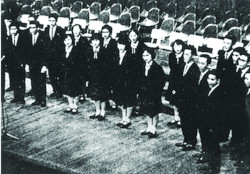

In inter-school verse speaking competitions, Mr. Cheung Nip-fung, who was in charge of artistic education, created a unique style of verse speaking that emphasized emotion, intonation and breath control. In 1964, the school won the first prize in the senior division with "Coming Back to Qiang Village" and the first prize in the junior division with "My Cottage Unroofed by Autumn Gales," causing a sensation in the Hong Kong education sector. In 1976, the school's senior choral verse team won first prize for "Farewells to a Wheelbase Melody to General Feng Setting out on an Expedition to the West" and "The Yangzhou Adagio." In 1977, the team won the first prize again with "Sentimental Verse at Heritage Sites" and "To Wang Lang," and subsequently won the overall championship in the finals held at Wah Yan College. In 1978, the team won the first prize with "Crossing the Plain" and "Lyrics to the Water Dragon Chant," achieving a remarkable three-year winning streak. In the 1964 Inter-school Music Competition, the school won eight championships. In the 20th Schools Athletic Meet, the school won four championships and ten runner-up positions. In late 1965, the school staged the large-scale music, poetry, and dance drama "The Rising Sun," featuring 200 performers, and received praise from all sectors of Hong Kong society.


During the 1969 school anniversary, the school held sports performances at the Kowloon Elizabeth Hall, the main school, and Tsuen Wan District, attracting over 10,000 spectators. These activities and achievements fully demonstrated the vigorous development of the school's physical education and arts programs and cultivated many talented individuals in these areas.
In the winter of 1969, a major fire broke out in the Kowloon City squatter area, and teachers and students from the school joined residents in firefighting and rescue. When floods occurred in Tsuen Wan and Tai Po, our teachers and students also participated in rescue and visited the affected residents, demonstrating the school's tradition of community involvement and care.
The 1970s
The 1970s marked a period of significant growth and development for the school. To enhance the learning environment, enrich teaching resources, and improve the overall quality of education, a series of initiatives were taken. The Tsuen Wan and Tai Po branches expanded their classroom buildings in 1971 and 1973 respectively. In 1975, the main school added new classrooms and an indoor sports hall. The school also invested in audiovisual equipment, and in 1977, audiovisual and visual education rooms were opened, providing students with more engaging and interactive learning experiences.


In 1970, teaching and learning exhibitions were held at the main school, Tsuen Wan branch, and Tai Po branch, followed by the publication of a collection of exhibits. In 1978, at the school's anniversary, another teaching and learning exhibition was organized, showcasing laboratories and audiovisual classrooms to parents, alumni, and members of the community.
Under the guidance of a holistic approach to education that emphasized moral, intellectual, and physical development, the school's sports and cultural activities flourished in the 1970s. In 1971, during the school anniversary, nine sports performances were held at the Elizabeth Hall, Tsuen Wan, and Tai Po, attracting over 1,200 athletes and 20,000 spectators. In 1972, the school's dance performance "The Red Cloud" was warmly received by audiences and won an inter-school award.
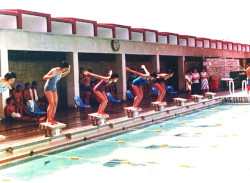

The school's athletics team achieved remarkable success in the 1973 inter-school athletics competition, winning championships in various categories and garnering significant media attention. The school's traditional Chinese music ensemble also won two chamionships and one second prize in the inter-school competition in 1973.
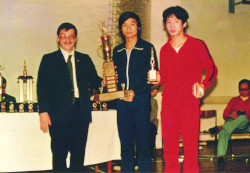

Throughout the 1970s, the school continued to excel in sports and arts competitions. For instance, the handicraft team won various championships in the 1974 inter-school competition, and the dance team's innovative performance, "The Rainbow Flower," which combined techniques from martial arts and dance, received widespread acclaim.
Despite the social unrest in Hong Kong during the 1960s and early 1970s, our school maintained a strong focus on academic excellence and discipline. The school's high passing rates in public examinations, coupled with its emphasis on hard work and respect for teachers, fostered a positive learning environment. For example, in 1956, when schools across Hong Kong were forced to close due to the Kowloon Riots, our school was one of the first to resume classes.
In the 1970s, with the rapidly changing political atmosphere in China, the school placed a strong emphasis on patriotic education. Despite enrolling over 10,000 students at one point, the school maintained high academic standards. In 1978, when mainland Chinese universities began admitting students from Hong Kong and Macau, the school's graduates achieved excellent results in the college entrance examination, attracting the attention of several mainland universities.
The 1980s
Entering the 1980s, our school implemented a diversified educational approach in response to the evolving needs of the time, striving to cultivate a more diverse range of talents.

In August 1980, the evening school was restructured to offer English language courses. In 1983, the branch school added senior high English classes and established the Heung To Language and Commerce School in Tsuen Wan. In 1981, the senior high school introduced commerce classes in addition to the existing arts and science streams for fourth-year students. In 1983, a computer room was added to the main school.

Since the 1980s, the school's performance in the Hong Kong Certificate of Education Examination and the Higher Level Examination improved year by year. The number of students admitted to the Chinese University of Hong Kong has also increased steadily from over twenty to nearly one hundred by 1982, leading to the establishment of the Heung To Alumni Association of the Chinese University of Hong Kong that same year. Shortly after, alumni studying in tertiary institutions in Hong Kong formed the Heung To University Students' Union.

During this period, the school's cultural and sports activities continued to flourish. In 1980, our school's gymnastics team won the championship in the Inter-school Gymnastics Competition for four consecutive years, and also clinched the individual all-around gold, silver, and bronze medals. In 1985, the boys' team continued its winning streak and won the gold and silver medals in the senior boys' individual all-around category. In the 16th Dance Festival in 1980, our school's "Harvest Dance" won the Outstanding Award for Oriental Folk Dance and the Choreography Award.

In 1977, the junior and senior forms of the Tsuen Wan branch school won first place in the choral verse speaking competition with "The Evening Glow" and "In Praise of the White Poplar". In 1980, the junior and senior forms of the main school won first place in choral verse speaking with "The World of Fire and Iron" and "The Thunderstorm". In 1981, the junior and senior forms of the main school once again won first place in the choral verse speaking competition with "Wuyi - A Thousand Wonders" and "The Yellow River Cantata". In 1982, the junior and senior forms of the main school won first place in the prose reading competition with "Lotus Leaf Chant". Thus, our choral speaking team achieved a remarkable seven consecutive championships starting from 1976, a significant achievement for our school.
A special edition commemorating the 39th anniversary of the school was published in 1985, featuring articles on the school's educational experiences over the years and reviewing its achievements in academics, morality and physical education, inspiring all teachers and students to build on the foundation and continue to innovate.
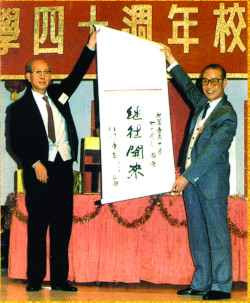
In 1986, the entire school community enthusiastically celebrated the 40th anniversary of the school and published the "Heung To Forty Years" anniversary special edition. During the anniversary celebration, the main school held an open day to welcome parents, alumni, and members of the community. In addition, a gathering was held for parents, teachers and alumni, with many alumni from home and abroad attending the activities.
In August 1986, Mr. Li Shulong continued to serve as the school supervisor, while Mr. Yang Yaozhong took over as principal. Due to the development of school affairs, a School Management Committee was established in September 1986 to lead the entire school. Mr. Li Shulong served as the chairman, with school directors Li Baogan, Ye Huizhen, He Qinzan, Zhang Zhongxi, and Zeng Jinxiang, as well as Principal Yang Yaozhong, Vice Principal Liang Jianming, Director Zhuang Lidu, and Secretary Li Zhaowen serving as committee members.
In 1987, Xie Anqi, Lin Ziying, and Zi Liqin won the first, second, and third prizes respectively, in the third Yuhua Award of the Chinese Students' Writing Competition. Our school also participated in the Hong Kong Secondary School Mathematics Competition and won a group award, ranking fourth.
In 1988, the Chinese name of the evening school was changed to "Heung To English and Commerce Evening School".
During this period, all teachers and students actively raised funds for disaster relief in Yunnan Province and for domestic water disasters.
Looking back on the first forty years, our school has consistently adhered to the educational philosophy of all-round development in morality, intellect, and physical education. Since its establishment, we have strived for excellence, and continuously reformed and improved. We have built a number of school buildings, all thanks to the care of people at home and abroad, the support of our parents and alumni, and the efforts of our teachers and students.

The 1990s
The 1990s marked a period of significant growth and transformation for Heung To Middle School, as Hong Kong moved towards its reunification with China.
In September 1991, following years of effort by the Board of Governors, the main school was approved as one of the first Direct Subsidy Scheme Schools in Hong Kong. Mr. Yang Yiu-chung assumed the role of principal of the main school, while Mr. Chong Lap-do became the principal of the branch school. Mr. Li Shut-lung continued as the school supervisor.


After years of planning, the reconstruction of the main school campus began in the summer of 1992. The new campus featured 26 standard classrooms, 13 special rooms, a large auditorium, and both indoor and outdoor sports facilities. A "Heung To Middle School Main Campus Reconstruction Committee" was formed to oversee the project, chaired by Mr. Ng Ping-cheong, with Mr. Li Shut-lung as the standing chairman.
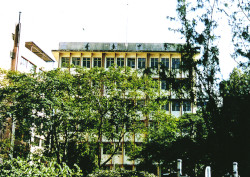
While the old campus in Tai Hang Tung was demolished in 1992, the school was temporarily relocated to Tsz Wan Shan. Meanwhile, the Tsuen Wan branch school moved to Tai Wo Yuen in Tai Po in August 1993, expanding from junior secondary to senior secondary levels.
In August 1993, Heung To English College established branch campuses in both Tai Po and Tsz Wan Shan. In November, Heung To English Commercial College was renamed as Heung To College of Higher Studies, marking a new phase for the night school. Mr. Ng Yung-fai was appointed as the principal, with Mr. Li Po-kon continuing as the school supervisor.
The new main school campus in Tai Hang Tung was completed in July 1994, and classes resumed there in September. This marked a new chapter for the school as it prepared for Hong Kong's handover in 1997.
In 1994, the Tai Po branch school expanded to include Form 5 and applied for a two-year pre-university program, becoming the second Heung To school to offer a full range of classes from Form 1 to pre-university.

In March of the same year, Heung To College of Higher Studies applied to the Training Authority for vocational training courses, including Chinese computing, Putonghua, typing, and bookkeeping, which were well-received by working youth.
In April 1995, to celebrate the school's 49th anniversary, a grand ceremony was held to celebrate the completion of the new main school campus. Mr. Zhang Junsheng, Deputy Director of the Xinhua News Agency Hong Kong Branch, officiated at the ribbon-cutting ceremony.
In early 1995, Heung To College of Higher Studies established the Heung To Professional Training Centre, offering professional courses in collaboration with Evans Management Ltd. In March, an agreement was signed with the Higher Continuing Education College of Sun Yat-sen University. In June, a training course for the Bank of China Group was launched.
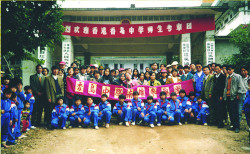
In October 1995, a delegation of school governors, parents, and staff visited Nanxiong, Guangdong Province, to attend the opening ceremony of the new Nanxiong Heung To Hope School. In 1996, the school celebrated its 50th anniversary with various events attended by alumni from around the world.

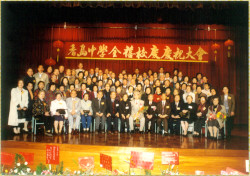

The Millennium

In the new millennium, our school chairman, Mr. Ng Ping Cheong was awarded the Silver Bauhinia Star by the Hong Kong Special Administrative Region. Principal Yang Yiu Chung was elected as a member of the second Legislative Council.

Heung To College established an Information Technology Training Centre in the year 2000, contributing to the territory's continuing education.
During this period, the school actively promoted information technology education. Both the main and branch campuses received funding from the Quality Education Fund to set up multimedia language learning rooms and implement school-based information technology programs. In response to educational reforms, we were one of the first to implement school-based curricula and invited top-notch teachers from mainland China to conduct teaching exchanges. Both teachers and students valued extracurricular learning activities. Every year, both the main and branch campuses organized study tours to deepen their understanding of the motherland.

In May 2000, the Education Department allocated a new school building that met 21st-century standards to our school, and a directly subsidized secondary school was established in Tin Shui Wai. It officially opened in September 2001, with Mr. Yang Yiu Chung as the principal.

In early 2000, the Heung To Education Foundation Limited was officially established. The chairman of the foundation was Mr. Ng Ping Cheong, and the vice chairmen were Mr. Li Po Kun (College Supervisor) and Mr. Tsang Kam Cheung (School Manager). The Heung To Education Foundation donated to 13 Hope Project schools in mainland China, including Qinghai, Shaanxi, and Guangdong.
On December 23, 2000, Mr. Cheng Siwei, a vice chairman of the National People's Congress and an alumnus, visited his alma mater for the second time. He held a forum with teachers and alumni, and gave a speech to teachers and students.

In 2003, Heung To Secondary School (Tseung Kwan O), located at 4 Kin Hok Street, was completed and opened, with Mr. Ng Yung Fai as the principal.

In 2010, our school celebrated its 65th anniversary. Adhering to the principle of patriotic education, we have been committed to whole-person education, diversified development, and keeping pace with the times. We will spare no effort to cultivate patriotic and Hong Kong-loving talents!

